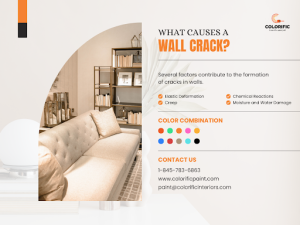Cracks in walls, if not promptly and correctly addressed, can lead to structural instability. These wall cracks affect both the aesthetic value and the structural integrity of your walls.
They can vary widely in size, depth, and pattern, and are commonly caused by factors like building settling, structural stress, and more. Keep reading to learn more about what causes wall cracks and how to fix them effectively using various Wall Repair Methods.

What Causes a Wall Crack?
Several factors contribute to the formation of cracks in walls:
Moisture and Water Damage
Changes in moisture levels, such as excessive water infiltration or drying, can cause building materials to expand or contract. This continuous cycle puts pressure on the walls, leading to cracks over time.
Elastic Deformation
While building materials are somewhat elastic, excessive stress can lead to deformation. This gradual strain leads to cracking, particularly in areas where the materials cannot accommodate the stress.
Creep
This is a phenomenon where walls under constant stress slowly deform over time. This long-term deformation often manifests as cracks, especially in load-bearing walls.
Chemical Reactions
Corrosion of metals or other chemical reactions within building materials can compromise the structural integrity of walls, leading to the formation of cracks.
Foundation Movement and Soil Settlement
Changes in the foundation due to soil conditions, uneven soil settlement, or poor soil compaction can place stress on walls. This stress can cause the walls to crack.
Growth of Vegetation
Plant roots near or under walls can cause structural shifts due to their growth, and the moisture from plants can exacerbate wall deterioration.
Why Is It Important to Repair Wall Cracks Promptly?
Repairing wall cracks is vital for maintaining the structural integrity and longevity of a building:
Stop Further Damage
Cracks can worsen over time and serve as entry points for moisture, leading to more significant damage. Prompt repairs prevent cracks from expanding and becoming more difficult and expensive to fix.
Keep the Building Strong
Unrepaired cracks can weaken load-bearing walls, compromising the building’s overall integrity. Timely repairs ensure that the structure remains solid and safe.
Make Spaces Look Better
Cracks can mar the visual appeal of a space. Repairing them helps restore the smoothness and uniformity of your walls, enhancing the overall aesthetics of the interior or exterior.
Save Money in the Long Run
Addressing cracks early on is cost-effective over the long term. Early intervention prevents the necessity of more extensive, costly repairs that could arise from neglecting smaller issues.
How to Permanently Fix Cracks on a Wall: Wall Repair Methods
To ensure a lasting solution when repairing cracks in walls, follow these systematic steps:
Check the Cracks
Start by thoroughly inspecting the cracks to understand their nature and extent. Determine whether they are superficial or indicative of more serious structural issues. Assess the width, depth, and pattern of the cracks to tailor your repair approach.
Clean the Surface
Clear the cracked area of any loose debris, paint, or other contaminants using a wire brush or scraper. This cleaning ensures a clean, stable surface for the repair materials to adhere to.
Prepare the Cracks
For wider cracks, create a V-shaped groove along the crack using a crack-chasing saw or a masonry chisel to provide a better base for the filling material.
Apply a Bonding Agent
Use a bonding agent or primer on the prepared surface to enhance the adhesion between the existing wall and the new repair material.
Choose the Right Filler
Pick a repair material that matches the type and size of the crack, like a special mortar mix, or consider using Heavy-Duty Wall Filler for larger areas.
Smoothing and Finishing
Smooth the applied repair material using a putty knife or trowel to ensure it blends seamlessly with the surrounding wall.
Paint and Restore
Once the filler is dry, paint or finish the wall to match the rest of the area. Use Wood Conditioner for Painting before painting over wooden surfaces to ensure a smooth finish.
Specific Repair Techniques
- Epoxy Filler for Wood Repair: Ideal for mending damaged wood, epoxy filler restores and strengthens wood surfaces.
- Drywall Patching Techniques: Learn to fix holes and tears in drywall using patch kits and joint compound for a smooth, seamless appearance.
When to Call a Professional – Colorific Paint
While you can fix minor cracks yourself, it’s better to call professionals for serious issues. For expert repairs, consider Colorific Paint. They handle everything from preparing the surface to finishing the repair, ensuring your building stays both beautiful and strong.
Read More:
How to Make the Most of Your Exterior Paints Purchase
The Ultimate Guide to Interior Paint Types
Trending Interior Paints Colors and Combinations
Commercial Painting Supplies: Essential Tools You Need for Successful Projects
Residential Painting Services: A Homeowner’s Guide to Professional Results
